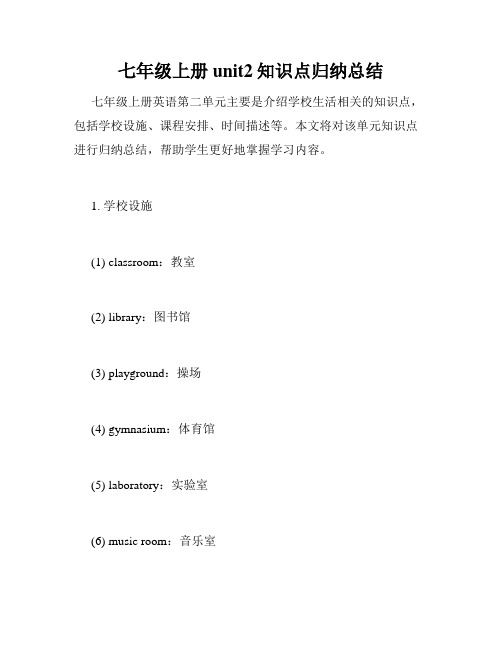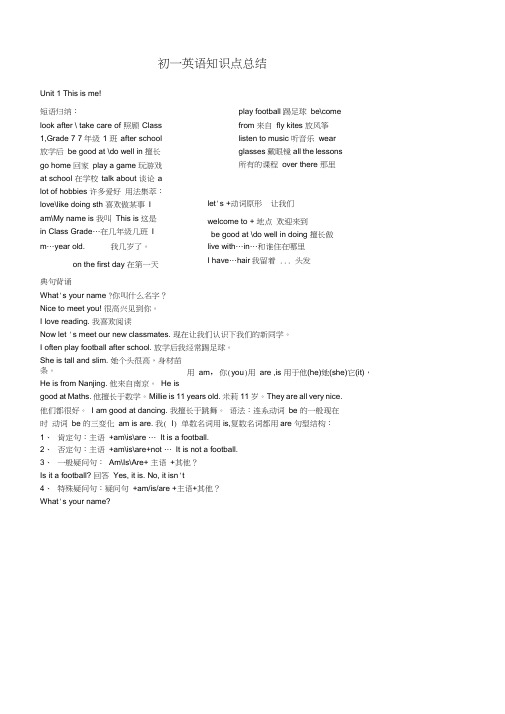七年级上册英语Unit2知识点归纳总结word版本
七年级上册英语Unit2知识点归纳总结.docx

七年级英语上册Unit2 知识点归纳总结Unit2 Topic1 I have a small nose.一、重点词汇1. 反义词:small - big / large long - short black - white tall -short new–oldyour/his/her favorite film star我的/你的/他的/她的最喜爱的电影明星from =be from来自、出生于different长得不像the same grade/school在同一个年级/学校in different grades/schools在不同年级 / 学校6. have / has有;吃;喝You have big eyes. She has small eyes.你有一双大眼睛。
她有一双小眼睛。
长的long hair长头发短的short hair短头发9. big大的big nose大鼻子10. small小的small nose小鼻子11. round圆的round face圆圆的脸12. wide宽的wide face宽宽的脸13. we我们We have small mouths.我们都有小嘴巴。
二、重点句型have a big nose = My nose is big.I have big eyes. = My eyes are big.She has a big nose. = Her nose is big.She has big eyes. = Her eyes are big.2. Who’s that boy那个男孩是谁这是由 Who引导的特殊疑问句,询问某人的身份。
如: Who’s that girl over thereWho’s 是 Who is的缩写形式。
名词和代词和am ,is ,are ,have ,has的连词都可以使用缩写形式。
助动词和情态动词的否定形式也可以缩写。
七年级上册unit2知识点归纳总结

七年级上册unit2知识点归纳总结七年级上册英语第二单元主要是介绍学校生活相关的知识点,包括学校设施、课程安排、时间描述等。
本文将对该单元知识点进行归纳总结,帮助学生更好地掌握学习内容。
1. 学校设施(1) classroom:教室(2) library:图书馆(3) playground:操场(4) gymnasium:体育馆(5) laboratory:实验室(6) music room:音乐室(7) art room:美术室(8) computer room:电脑室以上学校设施的名称需了解,并能正确使用它们进行简单的对话。
例如:A: Where is the library?B: It's next to the playground.2. 课程安排(1) timetable:课程表(2) subject:科目(3) English:英语(4) math:数学(5) science:科学(6) history:历史(7) geography:地理(8) PE:体育了解每个科目的名称,并能正确使用它们进行简单的对话。
例如:A: What's your favorite subject?B: My favorite subject is English.3. 时间描述(1) time:时间(2) o'clock:点钟(3) quarter past:15分钟过(4) half past:半点(5) quarter to:差15分钟了解以上时间描述的意思,并能使用它们进行简单的时间描述。
例如:A: What time is it now?B: It's half past six.以上是七年级上册Unit2的核心知识点,希望同学们能够认真学习记忆,掌握语言表达能力,提高英语水平。
(word完整版)人教版英语七年级上册所有单元知识点总结(2),推荐文档

七年级各单元知识点汇总Unitl My name 'Gina.重点短语1. your/his/her/my name 你的/他的/她的/我的名词2. first name 名字3. middle school 中学4. teleph one nu mber 电话号码5. last name 姓6. in Chi na 在中国重点句型1. —What 'your name?你叫什么名字?—Alan艾伦2. —I'm Jenny. Nice to meet you.我是珍妮。
见到你很高兴。
—Nice to meet you, too.见到你我也很高兴。
3. —Good morni ng! I 'm Ci ndy.早上好!我是辛迪。
—Hello, Ci ndy! I'm Dale .你好,辛迪!我是戴尔。
4. —My name 'Linda. Are you Helen?我是琳达。
你是海伦吗?5. —What 'her name?她叫什么名字?—She'Ja ne.她是简。
6. —Is he Jack?他是杰克吗?—No, he isn ' t. His namMke'.不,他不是。
他的名字是迈克。
7. What 'your phone number?你的电话号码是多少?It'587-6275.它是587-6275。
8. My friend is in China.我的朋友在中国。
重点语法2. Be动词的一般现在时形式:am, is, areI 用am You 用areIs用于他他它Unit2 This is my sister.重点短语1. family n ame 全家福2. have a good day (表示祝愿)过得愉快!3. a picture of 一张.... 的照片4. in the first phone 在第一张照片里5. family tree家庭关系图6. the name of ................... 的名字重点句型1. That 'my family. Those are my pare nts.那是我的家人,那是我的妹妹。
七年级上册英语第二单元知识点总结.doc

七年级上册英语第二单元知识点总结.doc7A UNIT 2 Daily life重点单词:daily 每天的article 文章never 从不break n. 休息v.打破打碎usually经常so 因此bell铃声ring 打电话,戒指seldom 很少ride,骑,乘guitar,吉他band乐队,传送带together,一起grade 年级Geography n. 地理;地形market,市场practice, 不可数名词,练习v.练习常考短语:junior high school 初中senior high school 高中primary school 小学on foot 步行take part in 参加go to bed 睡觉get up 起床have a good/great/wonderful time =enjoy oneself =have fun 玩得开心,愉快。
经典句型:1.How do /does... go to school?2.How long is...3.I alway have a good time...4.Is...close to...?5.Once a month ,I...6.How often do you...?7.They think ...as...详细讲解:1.Listen to a boy talking about his weekend.Listen ①不及物动词Listen!The boy is singing.②若要加宾语,要加“to ”如.:Pleasen listen to the teacher.Listen for 留心听2.辨析That ’sright .All right 与T hat ’sall right①That’s right对的,正确的。
(对别人所说的话表示肯定)②All right 好吧;身体康复了;令人满意的③That’s all right 不用谢;没关系(客气话和道歉的回应)3.Which of these things do you do once or twice a week?(page16)①助动词do/does/did 后面要跟动词原形;②once or twice a week 每周一两次注意:在英语中,表示一次用“once,”两次用“twice ,”表示三次或者三次以上就用“基数词+times (”time 在这里是可数名词,表示次数,需要加“s)”如:once a week,twice a week, three(four/ five ?)times a week4. brush one ’s t刷ee牙th(page16)Brush①在这里是动词,表示“刷”②n.可数名词,“刷子”复数形式是“brushes。
七年级上册英语unit2知识点归纳

七年级上册英语unit2知识点归纳本文将为大家归纳整理七年级上册英语Unit 2的知识点,旨在帮助学生更好地掌握这一单元所学内容。
一、重点词汇1. wake up:醒来例如:I usually wake up at six o'clock in the morning.2. get up:起床例如:I get up after I wake up.3. have breakfast/lunch/dinner:吃早/午/晚饭例如:I usually have breakfast at seven o'clock in the morning.4. go to school:去上学例如:I usually go to school by bus.5. do homework:做作业例如:I always do my homework after school.6. watch TV:看电视例如:I like to watch TV in the evening.二、动词时态1. 一般现在时例如:I usually wake up at six o'clock in the morning.2. 现在进行时例如:I am doing my homework now.3. 一般过去时例如:I went to the park yesterday.4. 过去进行时例如:I was watching TV when my friend called me.三、日常生活用语1. 问候例如:How are you?2. 对话例如:A:What time do you usually wake up?B:I usually wake up at six o'clock in the morning.3. 请求例如:Can you help me with my homework?4. 命令例如:Clean your room, please.四、其他重要知识点1. 序数词例如:first,second,third,fourth,fifth,sixth,seventh,eighth,ninth,tenth2. 人称代词例如:I,you,he,she,it,we,they总之,七年级上册英语Unit 2的知识点主要包括了一些基础的英语词汇、动词时态和常用口语表达等方面,希望大家通过本文的学习,能够更加熟练地运用这些知识点,从而提高自己的英语水平。
部编版七年级英语上册第二单元知识点总结

部编版七年级英语上册第二单元知识点总
结
本文档总结了部编版七年级英语上册第二单元的知识点,以下是具体内容:
1. 单词和词组
在第二单元中,我们研究了许多新的单词和词组,包括:
- Good morning:早上好
- How are you:你好吗
- Nice to meet you:很高兴见到你
- What's your name:你叫什么名字
- My name is:我的名字是
- Thank you:谢谢你
- Excuse me:请问
2. 语法知识
本单元主要介绍了一些基础的语法知识,包括:
- 人称代词的用法:如I、you、he、she等
- 动词be的用法:如am、is、are等
- 名词和代词的使用:如名字、人称代词等
- 简单的问句和回答的构成:如What's your name? My name is...
3. 阅读和写作技巧
在第二单元中,我们也研究了一些阅读和写作技巧,包括:
- 情景对话的理解和记忆
- 问句和回答的表达方式
- 简单的自我介绍写作
4. 文化背景
在研究英语单元的同时,我们也了解了一些与英语国家相关的文化背景知识,比如问候礼仪和命名俗等。
以上就是部编版七年级英语上册第二单元的知识点总结。
希望对你的研究有所帮助!。
人教版七年级上册英语Unit2知识点总结

人教版七年级上册英语Unit2知识点总结本文档总结了人教版七年级上册英语Unit2的重点内容。
单词- greet: 问候- introduce: 介绍- name: 名字- age: 年龄- hobby: 爱好- think: 认为- study: 研究- hard: 努力- make: 制作- friend: 朋友句型- What's your name? (你叫什么名字?)- How old are you? (你几岁?)- Nice to meet you. (很高兴认识你。
)- I think English is interesting. (我认为英语很有趣。
)- I study English every day. (我每天研究英语。
)- She likes playing basketball. (她喜欢打篮球。
)- He is good at drawing. (他擅长画画。
)- We make cakes at a party. (我们在聚会上做蛋糕。
)语法- 人称代词:I, you, he, she, it, we, they;- be动词的变化和使用:am, is, are;- 动词-ing形式的构成和用法;词汇运用根据课本中的对话,学会运用正确的词汇进行自我介绍和询问他人的信息。
例如:- A: Hi, I'm Lisa. What's your name?B: Nice to meet you, Lisa. My name is Peter.- A: How old are you, Peter?B: I'm 13 years old. How about you?- A: I'm 14. Do you like playing soccer?B: Yes, I do. I think soccer is fun.阅读理解通过阅读理解题目,加深对本单元知识的理解和应用能力。
(完整word版)牛津七年级上英语知识点总结

初一英语知识点总结Unit 1 This is me!短语归纳:look after \ take care of 照顾Class 1,Grade 7 7年级1 班after school 放学后be good at \do well in 擅长go home 回家play a game 玩游戏at school 在学校talk about 谈论a lot of hobbies 许多爱好用法集萃:love\like doing sth 喜欢做某事I am\My name is 我叫This is 这是in Class Grade…在几年级几班I m…year old. 我几岁了。
on the first day 在第一天play football 踢足球be\comefrom 来自fly kites 放风筝listen to music 听音乐wearglasses 戴眼镜all the lessons所有的课程over there 那里let's +动词原形让我们welcome to + 地点欢迎来到be good at \do well in doing 擅长做live with…in…和谁住在哪里I have…hair我留着 ... 头发典句背诵What's your name ?你叫什么名字?Nice to meet you! 很高兴见到你。
I love reading. 我喜欢阅读Now let 's meet our new classmates. 现在让我们认识下我们的新同学。
I often play football after school. 放学后我经常踢足球。
She is tall and slim. 她个头很高,身材苗条。
He is from Nanjing. 他来自南京。
He isgood at Maths. 他擅长于数学。
Millie is 11 years old. 米莉11 岁。
- 1、下载文档前请自行甄别文档内容的完整性,平台不提供额外的编辑、内容补充、找答案等附加服务。
- 2、"仅部分预览"的文档,不可在线预览部分如存在完整性等问题,可反馈申请退款(可完整预览的文档不适用该条件!)。
- 3、如文档侵犯您的权益,请联系客服反馈,我们会尽快为您处理(人工客服工作时间:9:00-18:30)。
七年级上册英语U n i t2知识点归纳总结七年级英语上册Unit2知识点归纳总结Unit2 Topic1 I have a small nose.一、重点词汇1.反义词:small - big / large long - short black - white tall - short new – old2.my/your/his/her favorite film star 我的/你的/他的/她的最喜爱的电影明星e from =be from 来自、出生于4.look different 长得不像5.in the same grade/school 在同一个年级/学校 in different grades/schools 在不同年级/学校6.have / has 有;吃;喝You have big eyes. She has small eyes. 你有一双大眼睛。
她有一双小眼睛。
7.long 长的 long hair 长头发 8.short 短的 short hair 短头发9. big 大的 big nose 大鼻子 10. small 小的 small nose 小鼻子11. round 圆的 round face 圆圆的脸 12. wide 宽的 wide face 宽宽的脸13. we 我们 We have small mouths. 我们都有小嘴巴。
二、重点句型1.I have a big nose = My nose is big.I have big eyes. = My eyes are big.She has a big nose. = Her nose is big.She has big eyes. = Her eyes are big.2. Who’s that boy?那个男孩是谁?这是由Who引导的特殊疑问句,询问某人的身份。
如:Who’s that girl over there?Who’s 是Who is 的缩写形式。
名词和代词和am ,is ,are ,have ,has 的连词都可以使用缩写形式。
助动词和情态动词的否定形式也可以缩写。
如:Who is =Who’s Who are =Who’re What is =What’s What are = What’reThat is =That’s can not=can’t do not =don’t does not =doesn’tTom is =Tom’s they are =they’re3. Where is he from? 他来自哪里?此句是where引导的特殊疑问句,旨在询问别人的家乡在哪里或对方的出生地。
询问“(某人)是哪里人”,常用Where …from? 结构。
be from相当于come from ,因此上句可改为:Where does he come from?4. That’s right. 是的,你说的对。
That’s right 是对某一观点、判断或回答作评判的用语,或对对方的说法表示赞同,常用That’s right, 表示“是的,对了,你说的对”等意思。
有时也可以用You’re right 或Right, OK来代替。
如:—Are you in Class One? 你在一班吗?—That’s right. 是的/ 没错。
5. I’m thirteen years old. = I’m at the age of thirteen. 我13岁了。
6.Please give this letter to Maria. She is in Class Four, Grade Seven.请把这封信给玛丽亚,她在七年级四班。
(1)give 动词,“给”。
give sth. to sb. “把某物给某人”相当于give sb. sth. 。
如:Please give this knife to Zhang Hua. Please give Zhang Hua this knife.(2) Class Four, Grade Seven “七年级四班”,英语中一般先说小的地方,后说大的地方。
这就是英语和汉语语序的区别。
7. Sorry, I don’t know her.对不起,我不认识她。
(1)I’m sorry是英语中最常用的交际礼貌用语之一,意为“对不起”,口语中也可直接用Sorry。
(2) I don‘t know her.我不认识她。
其中, know 有两种意思,一是“知道”,二是“认识”。
在此句中,就是第二个意思。
如:I don't know how to do this work. 我不知道如何去做这项工作。
Do you know this man? 你认识这个人吗?8. What does she look like? 她长什么样子?这是用来询问人的外貌的句型,可根据人的外貌特征直接进行回答。
如:—What does he look like?— He has a round face and big eyes.句中look like “看起来像……”,look为连系动词, 意为“看起来”,“看上去”,like 为介词,意为“像……” 如:I look like my mother.辨析:look like / be like(1)look like“看起来像”“看上去像……”,指“外观像……”。
(2)be like“像……一样”,指“品质、性格。
”如:What does he look like?他长什么样子?What is he like?他是一个什么样的人?三、重点语法have/has 的用法。
动词have作为"有"使用时,表示"某人(物)有……"用于第一、二人称单数I、you和复数主语,其单数第三人称形式为has,用于第三人称单数he、she、it和单数主语。
肯定句:主语+have / has+宾语。
例如:1. I have an English book.2. Lily has a dog.3. They have many friends.否定句:在have、has后直接加not。
主语+have not / has not+宾语。
例如:1. You have not a red car.2. She has not a new bike.3. Lily and lucy have not a big family.一般疑问句: 在英语中,要借助于助动词变为问句和否定句,但has要变为have。
在作回答时也要用do或does的形式。
否定句中,用"主语+don't / doesn't+have+宾语"。
例如:1. I don't have an English book.2. She doesn't have a new bike.一般疑问句中,用"Do / Does+主语+have+宾语"。
例如:1. Do you have an English book? Yes, I do. (No, I don't.)2. Does she have any friends? Yes, she does. (No, they doesn't.)特殊疑问句中,用"特殊疑问词+do/ does+主语+have+其它"。
例如:1. What do they have?2. How many friends does Lucy have?Unit2 Topic2 What does she look like?一、核心词汇 both black blue color pink red purple brown white green yellow here give letter sorry like tall will young man woman T-shirt shoe cap skirt dress at photo strong cool二、常用词组look the same give…to… look like look at look different三、重点句子We both have black hair and black eyes.We don’t have the same looks, but we are good friends.What color is/are….?She is tall like you,…I’ll give it to her. The girl in yellow is Maria.She has short brown hair. He is in a black cap and blue shoes.四、交际用语Please give this letter to Maria. Sorry I don’t know her.What does he/she look like? Oh, I see. Am I cool?五、语法精粹否定句We don’t have the same looks. He doesn’t have gray hair.特殊疑问句What color is her hair? It’s (red….)主谓一致What color are these shoes? They are (green…..)What color is his cap?It’s (yellow…..)介词短语作后置定语 The boy in blue pants is peter.定冠词the 的用法 I have a pen. The pen is red.六、重点讲解1.We both have black hair and black eyes.我俩都长着黑头发、黑眼睛。
both pron(与复数名词连用)意为“两个,两个都”。
Both 放在be 动词,助动词或情态动词后面,实义动词的前面。
如:We are both from Sichuan.我俩都来自四川。
They both work in Toronto. 他俩都在多伦多市工作。
2 But you look the same. 但是你们看起来一样。
We don’t have the same looks, but we are good friends! 我们没有相同的外貌,但我们是好朋友!以上两句中出现了look the same 与 the same looks 两个短语。
